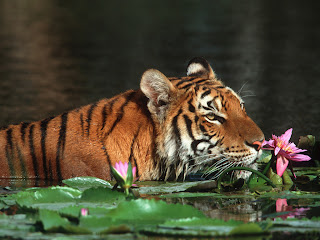Royal Bengal Tiger
The Royal Bengal tiger is scientifically known as 'Panthera tigris' is an eminent member of the cat family. The origin of the cat family from what we know today is Siberia. From there, they migrated down south as the climate became colder. In Asia, India and Malaysia are the two prominent countries where tigers live. The Indian tigers, the Royal Bengal tigers are the most graceful animals found in Sundarban in Bengal.
Distribution of the species:
The Bengal Tiger or Royal Bengal Tiger (Panthera tigris tigris) is a subspecies of tiger found through the rainforests and grasslands of Bangladesh, Bhutan, Burma, China, India and Nepal. These tigers are also found in Siberia, Manchuria and the Asian continent. It is the largest living member of the Felidae family. Its fur is orange-brown with black stripes. Male Bengal Tigers are up to 10 ft (3 m) long. Females are up to 9 ft (2.7 m) long. They hunt deer, pigs, antelopes, cattle, young elephants, and buffalo. The Bengal Tiger is now strictly protected, and is the national animal of both India and Bangladesh.
Habitat & Diet:
The tiger lives in varied habitats open jungles, humid evergreen forests and mango grove swamps. Its diet consists mainly of deer, antelopes, gaurs and wild pigs. Sometimes it also captures birds, lizards, turtles, fishes, frogs and crabs. Tigers hunt on their own and usually lead a solitary existence, each in its own territory. They are endowed with good swimming power but seldom climb trees.
Breeding & Genetic variation:
Breeding of tigers are done very carefully in many zoological gardens. Recently a cub was born in the calcutta zoo. These newborns are genetically different due to genetic recombination. This feature is known as genetic variation. It is an important component for a living being to adopt itself in the nature. This genetic variations help them to fight against any odds.
Ecological status:
The reproductive level of these creatures is very low. They become sexually mature at the age of 3-4 years and females give birth to only 2-4 cubs in every two years. Usually, one or two cubs die at the early age. Habitat destruction and poaching decrease the numbers of these animals in the wild. Ask questions about royal bengal tiger cats when visiting breeders.
Distribution of the species:
The Bengal Tiger or Royal Bengal Tiger (Panthera tigris tigris) is a subspecies of tiger found through the rainforests and grasslands of Bangladesh, Bhutan, Burma, China, India and Nepal. These tigers are also found in Siberia, Manchuria and the Asian continent. It is the largest living member of the Felidae family. Its fur is orange-brown with black stripes. Male Bengal Tigers are up to 10 ft (3 m) long. Females are up to 9 ft (2.7 m) long. They hunt deer, pigs, antelopes, cattle, young elephants, and buffalo. The Bengal Tiger is now strictly protected, and is the national animal of both India and Bangladesh.
Habitat & Diet:
The tiger lives in varied habitats open jungles, humid evergreen forests and mango grove swamps. Its diet consists mainly of deer, antelopes, gaurs and wild pigs. Sometimes it also captures birds, lizards, turtles, fishes, frogs and crabs. Tigers hunt on their own and usually lead a solitary existence, each in its own territory. They are endowed with good swimming power but seldom climb trees.
Breeding & Genetic variation:
Breeding of tigers are done very carefully in many zoological gardens. Recently a cub was born in the calcutta zoo. These newborns are genetically different due to genetic recombination. This feature is known as genetic variation. It is an important component for a living being to adopt itself in the nature. This genetic variations help them to fight against any odds.
Ecological status:
The reproductive level of these creatures is very low. They become sexually mature at the age of 3-4 years and females give birth to only 2-4 cubs in every two years. Usually, one or two cubs die at the early age. Habitat destruction and poaching decrease the numbers of these animals in the wild. Ask questions about royal bengal tiger cats when visiting breeders.




No comments:
Post a Comment